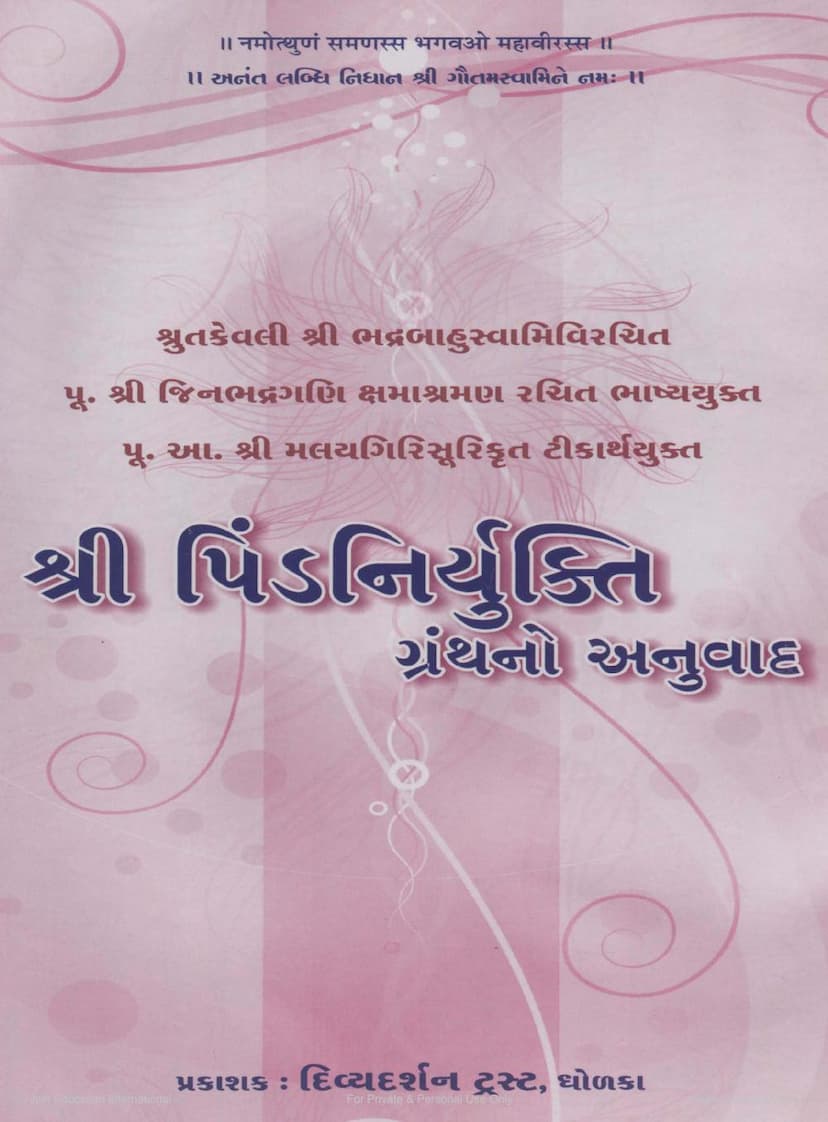Agam 41 Mool 02 Pind Niryukti Sutra
Added to library: September 1, 2025

Summary
Here is a comprehensive summary of the Jain text "Agam 41 Mool 02 Pind Niryukti Sutra" by Hanssagar Gani, published by Divya Darshan Trust, based on the provided pages:
Title: Agam 41 Mool 02 Pind Niryukti Sutra Author: Hanssagar Gani (as translator/researcher, building upon earlier works) Publisher: Divya Darshan Trust, Gholka
Core Theme: The Pind Niryukti Sutra, as presented in this translation and commentary, is a foundational Jain text that deals extensively with the principles and practices of Gochari (alms-seeking or collecting food) for mendicants (monks and nuns). It emphasizes the paramount importance of pure and faultless food (nirdaush/nirdosh ahar) as a crucial tool for spiritual progress and liberation (Moksha). The text aims to guide ascetics on how to procure, consume, and manage food in a manner that aligns with strict Jain principles of non-violence (Ahimsa) and ethical conduct (Samyama), minimizing harm to living beings and avoiding impurities.
Key Authors and Commentators: The text acknowledges several significant figures:
- Original Author: Shrutkevali Shri Shathambhavasuriji Maharaj (Dasvaikalik Sutra - Pancham Adhyayan 'Pichheshana').
- Author of Niryukti: Shrutkevali Shri Bhadrabahuswami Ji Maharaj (Pind-Niryukti).
- Author of Bhashya: Pujyapad Jinbhadra Gani Kshama Shraman.
- Author of Tikartha: Pujyapad Acharya Shri Malayagiri Suri Ji Maharaj.
- Original Translator: Pandit Jethalal Harilal Shastri, Bhavnagar.
- Translator-Researcher: Pujya Ganivarya Shri HanssagarGani Maharajshri (Pra Vachan Daksh Acharya Shri Anandasagar Suri M.Sa.'s grand-disciple).
- Inspiration for Re-publication: Pujya Acharya Bhagwant Shri Vijay Jagachandrasuri M.Sa. (Disciple of Pujya Acharya Shri Vijay Abhayachandrasuri M.Sa.).
Content Summary:
-
The Importance of Food (Pind): The text begins by establishing the fundamental role of food in life, not just for sustenance but also as a vehicle for spiritual discipline. It notes that the innate desire for food (ahara samjna) can lead to wandering in the cycles of birth and death (Chaturgati) and the perpetuation of sins and passions (Kashays). Therefore, the focus shifts to obtaining pure food as a means of self-purification and spiritual advancement.
-
The 8 Arthadhikaras (Sections of Inquiry): The core of the Pind Niryukti is presented through eight specific areas of inquiry related to alms-seeking:
- Udgama: Origin and genesis of the food.
- Utpadana: Production and preparation of the food.
- Eshana: The process of seeking and ascertaining the suitability of food.
- Sanyojana: The combination or mixing of food items.
- Pramana: The correct measure or quantity of food.
- Angara: Faults related to fire (cooking).
- Dhum: Faults related to smoke (cooking).
- Karana: The reasons or intentions behind the action.
-
Detailed Analysis of Eshana (Seeking Food): A significant portion of the text is dedicated to Eshana, which is further categorized into:
- Gaveshana: The initial seeking and examination.
- Grahaneshana: The actual acceptance of the food.
- Grasheshana: The consumption of the food.
-
Classification of Faults (Doshas): The text meticulously outlines numerous faults (doshas) that can render food impure or make its collection ethically problematic. These faults are discussed in relation to the eight Arthadhikaras. For instance, under Udgama, there are 16 types of faults discussed, and under Eshana, there are further detailed classifications like:
- Gaveshana Faults: Related to the householder's actions (e.g., 16 faults in Adhikarma).
- Grahaneshana Faults: Related to both the mendicant and the householder (e.g., 10 faults like Shankita, Prashita).
- Grasheshana Faults: Related to the process of consumption.
-
Focus on Purity and Non-Violence: A central tenet is the prevention of harm to living beings (Jiva) at all stages, from the origin of food to its consumption. The text details how various actions by householders (e.g., specific cooking methods, using impure ingredients) and mendicants (e.g., improper seeking, accepting forbidden items) can violate these principles.
-
Detailed Enumeration of Faults: The text provides a systematic and exhaustive list of faults. For example, under the Udgama section, 16 specific faults are elaborated upon, which include issues related to the origin of the food, how it was prepared, and the intentions behind it. Similarly, Eshana is broken down into Gaveshana, Grahaneshana, and Grassehana, each with its own set of faults (e.g., faults related to Pind - the collected food items).
-
The Nalikara Analogy: The text uses the analogy of a bee (madhukar) for the mendicant's alms-seeking. Just as a bee collects nectar from flowers without harming them, a mendicant should collect food with utmost care, seeking only the pure essence and causing no distress to the giver or the environment.
-
The Importance of Intent (Bhava): The text highlights that the intention behind an action is as critical as the action itself. A pure intention (subha bhava) while performing activities like collecting food or observing vows can lead to spiritual merit (punya), while a impure intention (ashubha bhava) leads to demerit (papa) and karmic bondage.
-
Re-publication and Gratitude: The publication information expresses gratitude to the lineage of Acharyas and highlights the meticulous work of Ganivarya Shri Hanssagar Maharajshri in researching and translating the work, making it accessible to a wider audience. The re-publication is dedicated to the memory of Acharya Shrimad Vijay Bhuvanbhanusurishwarji Maharaj (on his birth centenary) and Punyasri Padma Vijaya Ji Maharaj (on his 50th anniversary of renunciation).
In essence, the Pind Niryukti Sutra, as translated by Hanssagar Gani, serves as a comprehensive manual for Jain ascetics on the ethical and spiritual dimensions of food procurement and consumption. It aims to ensure that every action related to sustenance is performed with purity, mindfulness, and a deep commitment to non-violence, thereby facilitating the path to liberation.